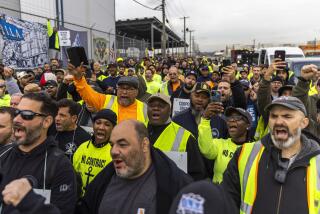Easing Seen in Ship Backlog at Area Ports
Delays at the ports of Long Beach and Los Angeles, which process 40% of U.S. ocean shipments, are abating as the pace of holiday cargo slows, new employees start work and ships are diverted, port and union officials said Tuesday.
Cargo is being held up about two days, down from four days in late September, and delays should end by early December, said James McKenna, executive director of the Pacific Maritime Assn. The backlog of ships waiting to get to a dock fell to 77 from a peak of 94 in October.
Merchandise for companies such as Wal-Mart Stores Inc., the world’s biggest retailer, has piled up at the two biggest U.S. ports since July as imports rose and railroads and truckers struggled to move goods inland. Cargo from Asia, such as holiday toys, climbed at least 10% this year from last year’s record pace at the ports, which process 24,000 containers a day.
“The backlog is starting to be worked off but not quickly enough,” said McKenna, whose association’s members include the biggest container carrier, Maersk Sea Land, a unit of Denmark’s A.P. Moeller Group. “Once you get into a backlog, it’s hard to dig out. We have to make sure we don’t become the people who leave the gifts on the dock.”
Cargo companies are training 2,500 people under a July agreement between the association and the International Longshore and Warehouse Union, representing Southern California dockworkers, said Dave Arian, president of Local 13.
Two dozen freighters, including ships of companies such as Hyundai Merchant Marine Co. of South Korea and Neptune Orient Lines of Singapore, were diverted to ports including San Diego to avoid delays, said the Southern California Marine Exchange, which tracks ship movements.
The backlog of ships exceeded the average 35 to 50 vessels about four months ago as Union Pacific Corp. and Burlington Northern Santa Fe Corp., the biggest U.S. railroads, set limits on shipments.
Congestion expanded to roads as trucks shifted cargo from ports to rail yards as far as 20 miles away, said Dan Smith, a consultant for Philadelphia-based Tioga Group.
“Every year the ports have a problem in the peak season,” said Smith, who has studied cargo patterns for a regional government group. “The problems are coming up earlier in the year and lasting longer.”
A rise in Asian imports caused a cargo surge late in the second quarter this year instead of during the third quarter. The surge should end next month instead of winding down in November, McKenna said. “The game has changed,” he said.
More to Read
Sign up for Essential California
The most important California stories and recommendations in your inbox every morning.
You may occasionally receive promotional content from the Los Angeles Times.










